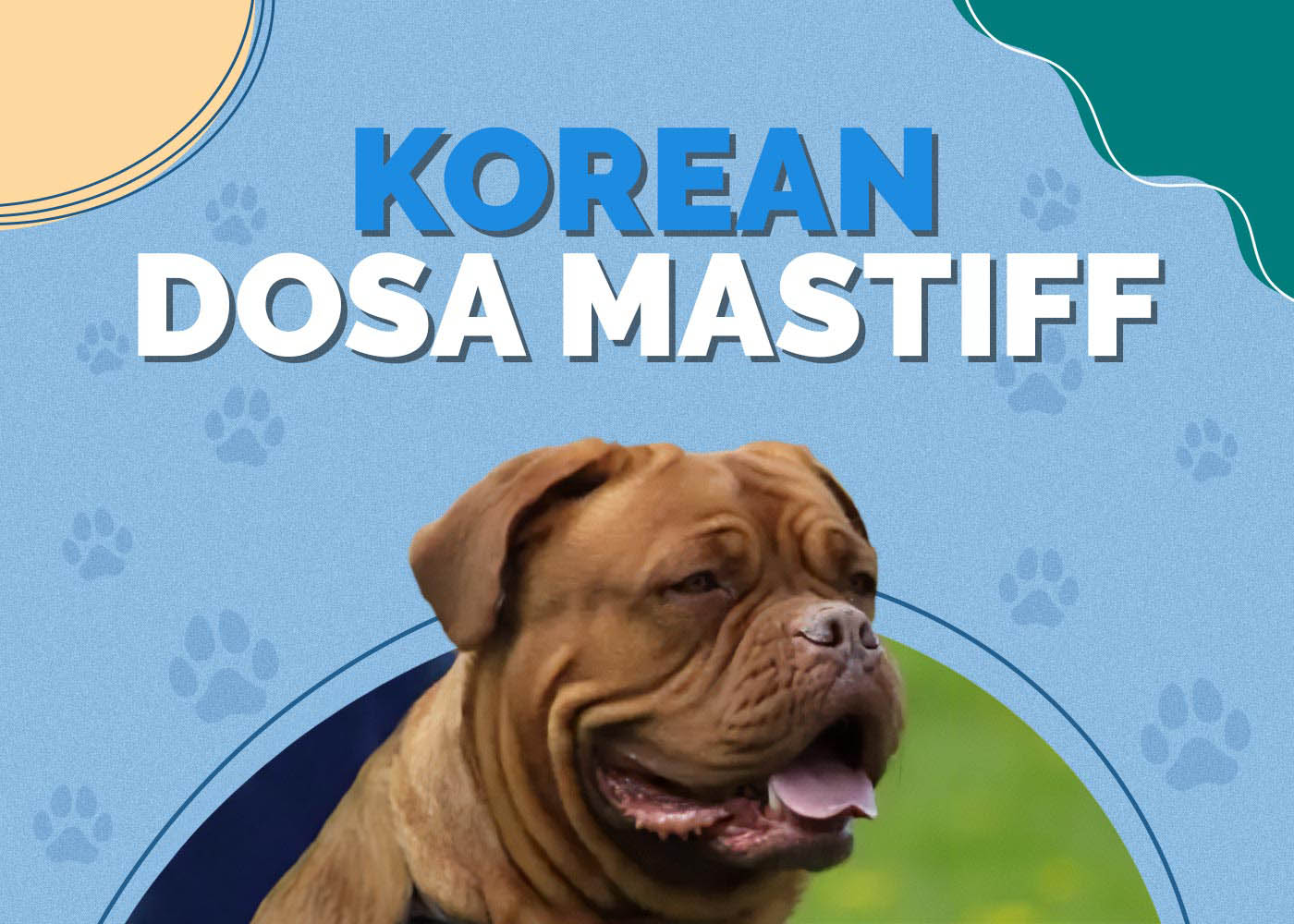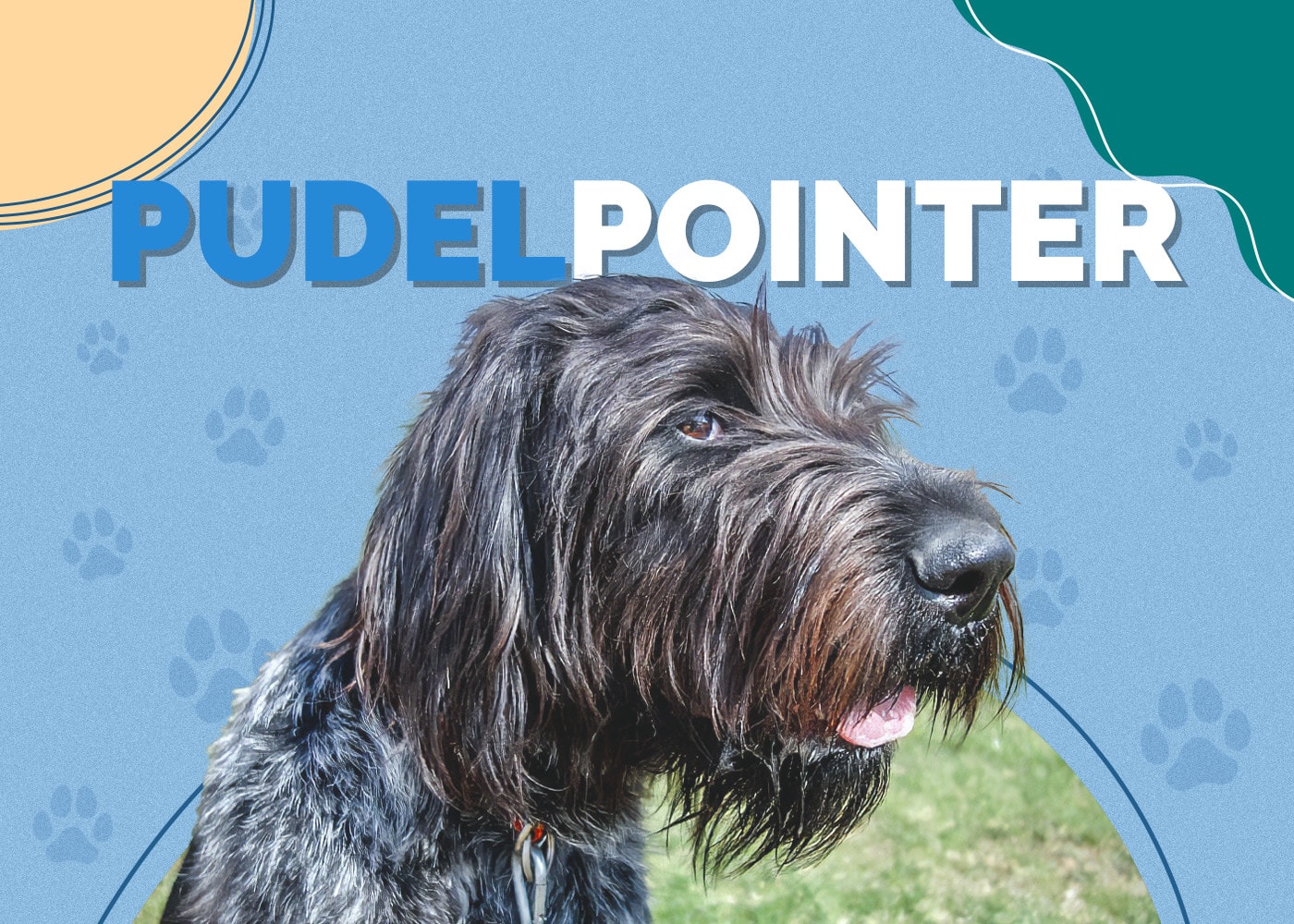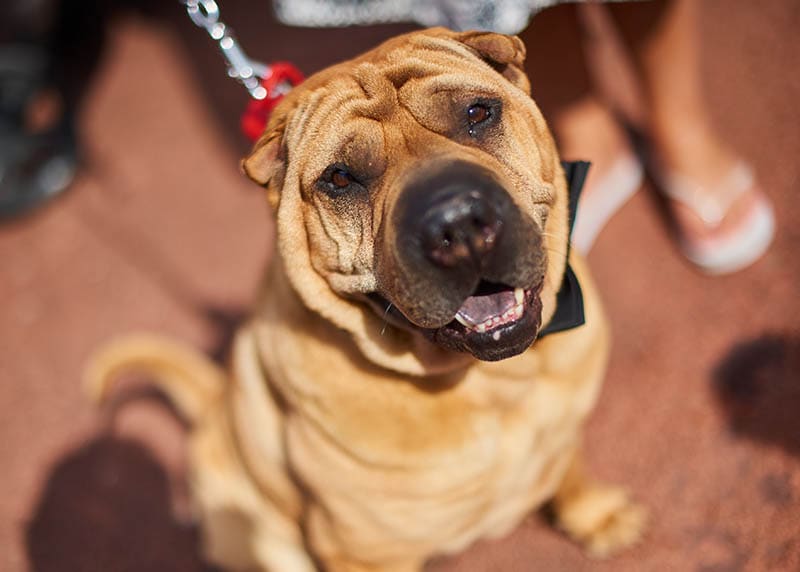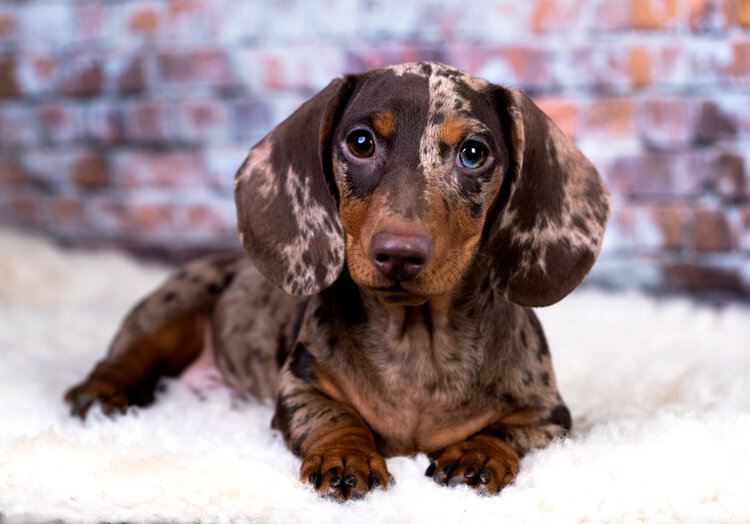Korean Dosa Mastiff: Info, Pictures, Characteristics & Facts
Updated on

| Height: | 22-30 inches |
| Weight: | 145-185 pounds |
| Lifespan: | 7-12 years |
| Colors: | Chocolate, mahogany, red |
| Suitable for: | Active families, those looking for a giant dog |
| Temperament: | Sweet, loyal, dominant, affectionate, friendly |
If you want a dog that’s both massive and rare, the Korean Dosa Mastiff will be perfect for you. These pups are absolute giants that are not widely known outside of their native South Korea.
These dogs are incredibly sweet and adorable, and they kind of resemble huge bloodhounds that are melting. They have loose skin, and it can sometimes seem that they can’t see due to all the wrinkles in their face.
Chances are that you’re not familiar with this breed, so if you’d like to learn more about these wonderful monstrosities, the guide below will fill you in on everything you need to know.
Korean Dosa Mastiff Puppies
Full-grown Korean Dosa Mastiffs are extremely wrinkled, with loose skin around their neck and faces. As puppies, they seem to have even more loose skin — as if they were given their bodies second-hand and haven’t grown into them yet.
In fact, even calling them “puppies” feels a bit misleading, as these dogs are never small. Even at just a few months old, they’re already bigger than many other breeds will ever be.
Besides the ample skin folds, the biggest clues that reveal how large these dogs will eventually become are their ears and feet. Their ears drape down to well below their chin; they’re not quite as big as a Basset Hound’s, but close.
Those humongous paws can do quite a bit of damage even at an early age. These dogs require time to figure out their bodies, so expect to get accidentally stomped on quite a bit as they learn where all their individual pieces are at any time. Given that these dogs often weigh upward of 30 pounds within a few months of birth, those stomps can be quite painful indeed.
It’s impossible to stay mad at them, though. Besides being absolutely adorable, these puppies are completely guileless, so they’ll simply apologize with a few sloppy kisses, and you’ll immediately forgive them — simple as that.
Temperament & Intelligence of the Korean Dosa Mastiff 🧠
Despite their ferocious appearance, the Korean Dosa Mastiff is a sweet-natured dog. They’re extremely loving toward their families and consider themselves to be lap dogs, so watch out when you sit on the couch.
They’re also welcoming toward strangers. You won’t have to worry about having guests over, as the dog will primarily be concerned with getting as much affection as possible from all the new people. Despite this, though, they make excellent guard dogs (would you mess with one of these pups?).
You would think that a dog this size would need a huge home, but they’re incredibly easygoing, with minimal exercise needs. They can take to apartment life or country living equally well.
They’re moderately intelligent, but it can be hard to adequately gauge their IQs due to their extreme laziness. They can be geniuses at getting out of work, though.
Given their Bloodhound DNA, you may have better results appealing to their intelligence via their noses rather than their eyes. That is to say, allowing them to sniff the tasty treat that you have for them will likely garner more compliance than merely showing it to them.
Are These Dogs Good for Families? 🏡
You might suspect that the Korean Dosa Mastiff is too dangerous to have around your family, given its fighting history and immense size. However, as long as they aren’t raised to fight, these dogs tend to be gentle giants.
They’re extremely patient with small children, but you should never leave them alone with your kids. That patience can run out eventually, so teach your little ones how to behave around dogs, and make sure they don’t pull their tails, step on their paws, or torment them in any way.
You do need to be careful, though, as these dogs can get exuberant and are as prone to zoomies as any other breed. That can be fun to watch, but it can end badly if your 185-pound dog ends up bowling over your 3-year-old.
These pups tend to be a little lazy, so if you prefer watching Netflix to going on long hikes in the woods, they’ll happily sit by your side (or more accurately, in your lap) while you binge-watch your favorite shows.
They’re more than capable of hanging with you on an adventure, though. They’re often used as working dogs, and while they’d prefer to take things easy, they have plenty of stamina when they need it.
Does This Breed Get Along With Other Pets? 🐶 😽
As long as your Korean Dosa Mastiff is well-socialized, they’ll likely get along well with other dogs. However, they tend to try to dominate other animals, so you’ll need to watch out for that behavior to nip it in the bud.
They don’t have a particularly strong prey drive, which means they’ll often tolerate cats and other pets as well. However, proper socialization is key in this regard, and it’s usually better if the dog is introduced to the cat as a puppy.
These dogs don’t know their own size, so you need to make sure they don’t sit or lay on other animals by accident. They could seriously injure another pet without ever meaning to.
Things to Know When Owning a Korean Dosa Mastiff
Unless you’ve spent some time in South Korea, you’ve likely never come across a Dosa Mastiff, much less owned one. While the breed is fairly simple to own, they do have quirks that are worth knowing before you bring one home.
Below, we’ll walk you through important things to keep in mind when raising one of these dogs.
Food & Diet Requirements 🦴
As you might expect, Korean Dosa Mastiffs eat a huge amount of food. They can put away at least a bag of food per month, so plan on spending quite a bit on kibble if you adopt one of these animals.
You shouldn’t buy the bargain-basement stuff either. These dogs don’t live long, but you have a much better chance of extending their lifespan if you give them a high-quality kibble. Look for one that’s high in protein, fat, and fiber.
Avoid any food that uses corn, wheat, soy, or animal by-products. These inferior ingredients will drive down the price, but at the expense of your dog’s health. Not only do they lack nutrients, but they’re also stuffed with empty calories, and since obesity is a problem for these dogs, that’s the last thing you want.
You need to be careful not to overfeed these dogs. It may seem impossible to feed these huge beasts too much, but it can be done and it’s disastrous for them. Offer them two or three small meals per day rather than letting them free-feed.
Giving them smaller meals has a bonus. Korean Dosa Mastiffs are extremely prone to bloat, a potentially fatal condition, and larger meals are more likely to trigger that illness. By giving them a few small meals per day, you’ll keep them healthy and alive for longer.
Exercise 🐕
Given their propensity for obesity, ensuring that these dogs get a sufficient amount of exercise is extremely important. However, their lazy nature means that it’s often difficult to motivate them to work out.
Aim to give them about an hour of vigorous exercise per day. This can come in the form of a long walk, a game of fetch, or simply a little bit of wrestling. You don’t have to force them to run a marathon, but it’s essential that they get up and moving every day.
Mental stimulation is equally important. You can tax them mentally by giving them an extended training session, handing them a puzzle toy, or even offering them a bone to chew on. However, while this can do wonders for keeping them docile and relaxed, it won’t help much for keeping their waistline in check.
It’s important to ensure that they don’t have too much energy, because an excess of energy often leads to destructiveness. As you can imagine, these dogs can do quite a bit of damage when they put their mind to it, so you don’t want them having too much gas in their tank.
Be careful about how hard you work them while they’re still puppies, however. Their developing frames can’t handle much high-impact activity, so a bunch of running, jumping, or even stair climbing could give them lifelong injuries.
Training 🦮
These dogs can be walking disasters if they decide to become destructive or ill-mannered. As a result, it’s imperative that you train them thoroughly and often from day one.
However, training them can often result in a battle of wills. While these dogs are sweet and loving, they can also be incredibly stubborn and prone to displays of dominance. If you fail to earn their respect, they’ll walk all over you (often literally).
It’s because of this that these dogs are best-suited for experienced owners, as novices may not have the skills necessary to keep them in line. If they feel like they don’t need to respect you, it can impact every facet of your relationship — and you do not want to find yourself dragged down the street by a 185-pound dog that disregards your every command.
Don’t let this need to earn their respect cause you to mistreat them, though, as punishing them often just causes them to dig their heels in deeper. Use positive reinforcement techniques instead.
They tend to be highly food-motivated, so you will likely have better luck using treats than praise alone. Don’t overdo it, though, because you don’t want them getting fat while learning how to behave properly.
Grooming ✂️
These dogs have short, bristly coats that aren’t overly prone to shedding. However, you may still want to take a slicker brush to them once a week or so, just to keep everything under control.
They only need to be bathed when they become visibly dirty, but you’ll want to take a wet rag and clean their wrinkles out regularly. If you let bacteria build up in the folds of their skin, an infection might form that requires more serious veterinary intervention.
They slobber in unbelievable amounts, so you might want to invest in scuba gear for when they climb into your lap. There’s not much you can do about it, other than to wipe it off every time they coat you or your clothes with it.
Other basic grooming needs include trimming their nails, brushing their teeth, and cleaning their ears out regularly. If you stay on top of these basic tasks, you should be able to avoid a variety of more serious health concerns.
The Korean Dosa Mastiff is largely a low-maintenance breed, but that doesn’t mean you can neglect them. Fortunately, they tend to accept grooming with good humor, so you shouldn’t have to wrestle them to make them presentable.
Health and Conditions ❤️
Korean Dosa Mastiffs have short lifespans, as do most dogs of their size. However, they usually manage to stay fairly healthy while alive, so you shouldn’t have to worry about paying exorbitant veterinary bills.
All of that is predicated on keeping them slim and trim, though. If you allow them to become overweight, the chance that they’ll suffer from serious health issues skyrockets. Keeping them in good shape will save them from a variety of painful conditions and save you from spending entire paychecks on their healthcare.
Their most common issues involve their eyes and joints. The eye problems are often due to poor hygiene, so it’s essential to keep them as clean as possible. The joint problems may be unavoidable, but keeping their weight under control will help immensely.
Bloat is another serious concern. Make sure you feed them smaller meals and limit their activity for at least half an hour after eating.
You can’t ensure that your Dosa Mastiff will stay completely healthy their entire life, but if you keep an eye out for the following conditions, you may be able to curb serious issues before they get out of hand.
- Entropion
- Cherry eye
- Skin and ear infections
- Bloat
- Hip dysplasia
Male vs. Female
Males are bigger than females; the difference can be sizable, as boys can easily outweigh their feminine counterparts by 20 pounds or more. However, regardless of which sex you bring home, you’ll have a massive dog on your hands.
There aren’t many personality differences between the sexes, although males tend to be a bit more playful, while females are more independent. Regardless, your dog should be loyal, affectionate, and stubborn.
3 Little-Known Facts About the Korean Dosa Mastiff
1. A Pair of Korean Dosa Mastiff Puppies Once Sold for Over $300,000
In 2016, an Indian man in Bengaluru paid $302,051 for a pair of Korean Dosa Mastiff puppies. The man said that buying the puppies was a culmination of a 20-year search for the dogs, which he had loved his entire life.
The man was a dedicated dog lover, as he also had 15 other dogs at the time of acquiring the Mastiff puppies. Hopefully, those were much less expensive than his new puppies.
2. This Dog Is an Amalgamation of Many Other Huge Dogs
The breed was developed around 200 years ago, and it was created using a mix of Neapolitan Mastiff, Bloodhound, Dogue de Bordeaux, St. Bernard, and English Mastiff. Those are all heavyweight dogs, so it’s no surprise that the Korean Dosa Mastiff would be such a giant.
If you look closely, you can see bits and pieces of each of those breeds in the Korean Dosa Mastiff, with the Bloodhound and Mastiff being the most prominent.
3. It’s a Wonder They Can See Anything at All
All those wrinkles often dangle over their eyes, which you would think would obscure their vision. It doesn’t seem to bother the dogs, though, as they can navigate just fine, and they only knock over as many things as your average Mastiff would.
That’s likely due at least in part to the Bloodhound genes in this dog. They have a powerful sense of smell that helps them get around, which is somewhat rare for a brachycephalic breed such as this.
https://www.instagram.com/p/CEw134EIkJl/?utm_source=ig_web_copy_link
Final Thoughts
The Korean Dosa Mastiff is an extremely rare breed but is capable of quickly capturing your heart. These dogs are huge, but they’re absolute lovebugs, so they’ll spend most of their time curled up next to you — or on top of you, as the case may be.
While these dogs are easygoing, owning one is not without its challenges. They can be stubborn and difficult to train, and it’s often hard to convince them to get off their butts and exercise. They also don’t live very long, which may be the biggest drawback to owning one.
If you can get your hands on one of these dogs, you’ll likely find yourself forming a deep attachment to the Korean Dosa Mastiff. They make wonderful pets and better friends — but you’ll likely find that their friendship becomes even deeper when you have food in your hands.
Featured Image: PxHere














